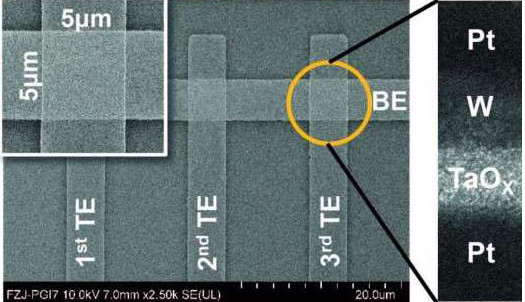Resistive memory not only stores data, it can process it too
March 12, 2017
on
on

One of the main bottlenecks in computing is the data bandwidth challenge. Because data storage (usually RAM) is separated from the data processing unit (usually the CPU), each and every calculation requires data to be moved from A to B and/or vice versa, wasting precious time. Many tricks to speed up this process have been developed, like pipelining, caching and look-ahead execution, but none of these techniques address the root of the problem: the separation of storage room and kitchen. Could it be that resistive memory is the solution?
Resistive RAM, also known as RRAM or RERAM, appears to be the memory of the future, and the first (small) memory devices based on this technology have become available. RERAM cells are simpler than classic transistor-based memory cells, they are non-volatile, switch fast and can run from low voltages. Researchers now have managed to make RERAM cells store more than just a ‘0’ or a ‘1’, enabling in-place computations.
Using so-called RERAM crossbar arrays researchers have demonstrated the in-memory execution of binary matrix computations frequently encountered in high-performance computing, algebraic cryptanalysis, combinatorics and finite geometry data, and in general large scale data analysis. Although we are only at the beginning of this technology, the results already are promising.
The mathematically inclined are invited to read the paper.
Resistive RAM, also known as RRAM or RERAM, appears to be the memory of the future, and the first (small) memory devices based on this technology have become available. RERAM cells are simpler than classic transistor-based memory cells, they are non-volatile, switch fast and can run from low voltages. Researchers now have managed to make RERAM cells store more than just a ‘0’ or a ‘1’, enabling in-place computations.
Using so-called RERAM crossbar arrays researchers have demonstrated the in-memory execution of binary matrix computations frequently encountered in high-performance computing, algebraic cryptanalysis, combinatorics and finite geometry data, and in general large scale data analysis. Although we are only at the beginning of this technology, the results already are promising.
The mathematically inclined are invited to read the paper.
Read full article
Hide full article


Discussion (0 comments)